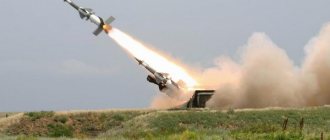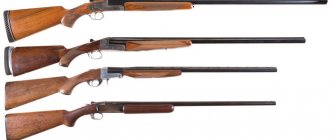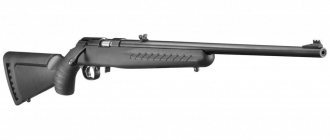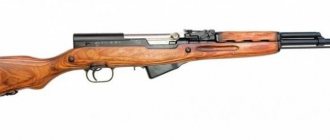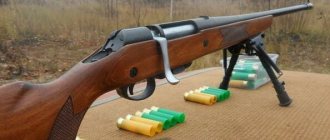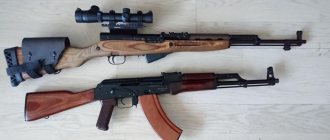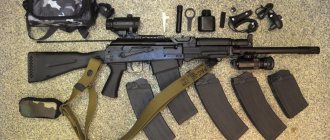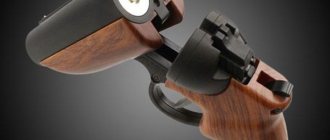The S-75 air defense systems, which appeared in 1958, could not provide reliable cover from air strikes of combined arms (tank) formations in military operations, since they had low maneuverability and a long deployment time. Therefore, there was a need to create a military air defense system on a tracked chassis, which has maneuverability no worse than the maneuverability of the combined arms (tank) formations and units it covers. The development of the 2K11 Krug air defense system began in 1958. Since the “Circle” was supposed to become a medium-range complex (and this required bulky missiles, transmitting and antenna devices for air defense missile systems), it was not possible to place all its elements on one tracked chassis.
History of creation
In 1956, research began on the possibility of creating military air defense for army-front purposes using rocket technology. They were held on a competitive basis as part of research projects such as “Topic 2” and “Topic 3”. The main leaders of these works are from NII-20 - V.P. Efremov, holding the position of chief executive, from OKB-8 - L.V. Lyulev and from TsNII-58 - V.G. Grabin (they were the supervisors of the work).
By mid-1958, all co-executors received technical assignments, and on the basis of the draft tactical and technical requirements, they adopted a resolution of the Council of Ministers of the USSR on the implementation of the “Circle” design and development work.
In the winter of 1961, after the launches, the correct direction of development of the complex was confirmed. Then the development of the components of the complex began and testing began, which took place in 3 stages.
At the first stage, factory tests were carried out according to the methodology and program of the lead R&D contractor.
On the second, joint state tests were carried out using methods that were developed by the test site.
At the third stage, periodic testing of serial samples was carried out. In the period from 1963 to 1964, state tests were passed.
In the winter of 1965, by order of the USSR Ministry of Defense, the air defense missile system was issued in 1963 to the summer of 1964. On February 3, 1965, by order of the USSR Ministry of Defense, the Krug air defense system entered service with military air defense.
What were the requirements for the Krug air defense system?
- Interception of air targets flying at speeds of up to 600 meters per second at altitudes from 3,000 to 25,000 meters.
- The probability of destruction of aircraft in the air such as the IL-72 front-line bomber at altitudes up to 20,000 meters is no less than 80%.
- Detection of targets with an effective dispersion surface such as the Mig-15 fighter at a distance of at least 115 km.
It is also worth noting that the government has set a strict time frame for the developers. The first tests were to take place in the third quarter of 1961. As already noted, designer V.P. was appointed project manager. Efremov, who was already working on improving the air defense and radar systems of the city of Moscow.
Difficulties in developing the Osa air defense system
The development of the Osa air defense system in the USSR also progressed rather slowly. The appointed design bureaus and research institutes did not cope with the assigned tasks. Some chief designers responsible for the development of various components were replaced by others, but this measure did not help either.
In the fall of 1964, a new developer was appointed, who became the SAM-MKB Fakel. Then the chief designer of this enterprise was Grushin. The development of a floating self-propelled chassis was also transferred to another enterprise - the Bryansk Automobile Plant.
The chief designer of the air defense system was Efremov, director of the Research Institute of Radio Industry of the USSR Ministry of Radio Industry.
After such a large-scale reshuffle, the creation of the Osa air defense system went much more successfully and in 1970 the first prototype of the complex arrived at the Emba test site. There he successfully passed all the tests.
In the fall of 1971, the air defense system was handed over to the USSR Army, and a year later it entered service with the air defense of the Ground Forces. The public first saw the Osa air defense system at a military parade taking place in November 1975 on Red Square in Moscow.
Description and characteristics of the Osa air defense system
The Osa air defense system is capable of independently following motorized rifle and tank divisions in different weather conditions. Thanks to the unique chassis design, it has excellent buoyancy and visibility. It is also highly efficient and has good interference immunity.
Composition of the Osa mobile self-propelled air defense system:
- Charging machine.
- The 9A33B vehicle is equipped with missile guidance and launch systems.
- Intelligence systems.
- Guided missile 9M33.
Both the loading and combat vehicles are located on the BAZ-5937 floating chassis. This three-axle chassis has excellent off-road capability and can overcome water obstacles. In addition, it is equipped with the following devices:
- Navigation.
- Power take-off generator.
- Life support systems.
- Power supply systems.
This complex, in addition to being able to move independently, can be transported by rail or IL-76 cargo aircraft. The powerful engine provides the Osa air defense system with a maximum speed of up to 80 kilometers per hour on the highway. The complex moves on dirt roads at speeds of up to 55 kilometers per hour.
If necessary, the air defense system can generate dust at a speed of up to 10 kilometers per hour. In this case, the engine ensures the operation of a special water jet. As for the chassis, it is capable of towing trailers up to 7,200 kilograms.
A powerful radar station is responsible for detecting enemy air targets. It detects air targets both in motion and in place. In addition, the air defense system can identify targets according to the “friend or foe” principle.
Serial production of the Osa anti-aircraft missile system took place at two enterprises:
- The Izhevsk Electromechanical Plant was responsible for the production of the combat vehicle itself.
- The Kirov Machine-Building Plant was responsible for the production of anti-aircraft guided missiles.
It is worth noting that until 1975, the Osa air defense system was produced without major upgrades. And only this year the modernized Osa-AK air defense system entered service with the Ground Forces. The following changes have occurred:
- Instead of 4 9M33 missiles, 6 9M33M2 modification missiles appeared.
- The affected area has increased. Now the complex could hit aircraft whose speed reached 500 meters per second (the basic model could shoot down aircraft only if their speed did not exceed 420 meters per second).
- The location of radio-electronic equipment has changed. Most of it was placed on a new element base. Thanks to this innovation, it was possible to reduce the weight of the kit, increase overall reliability and reduce energy consumption.
- Rockets with new fuses. Their design has changed, which made it possible to reduce the minimum height for hitting targets from 50 meters to 25 meters.
As you can see, the modernized air defense system was significantly superior to the base model in terms of the above characteristics.
Tasks and goals
The government approved the terms of reference in 1958. According to him, it was necessary to develop 2 new anti-aircraft guided missiles - 3M10 and 3M8, with mixed and command type guidance, respectively.
The design team of OKB-8 was engaged in research in this direction under the strict leadership of S. Korolev, who subsequently became part of OKB-2 (an experimental design bureau) under the leadership of P. Grushin on the basis of TsNII-58.
In connection with the creation of new missiles, the need arose to develop new systems for launching anti-aircraft guided missiles, since the existing models simply did not pass the mark in many respects. To reduce the development time and unify parts of the Krug air defense system, it took the Kub project under development as a basis.
First tests
Trial launches began at the end of 1959. During them, the first shortcomings and errors in the development were discovered - when the rocket was separated from the launch site, the latter was destroyed and instantly became unusable. But, however, this did not upset or annoy anyone - the test work had just begun, and they were carried out precisely to identify such oversights. Everyone continued to do their job.
Anti-aircraft missile launcher "Krug"
By the end of 1960, 24 missile launches were carried out. Only half of them were considered more or less successful; in the remaining cases, either the rocket disintegrated in flight, or it simply fell to the ground after flying several hundred meters.
Expert opinion
Isaac Yakovich Zelder
Soviet astrophysicist, physical chemist, Doctor of Physical and Mathematical Sciences, Academician of the USSR Academy of Sciences, designer, engineer. Hero of Socialist Labor of the USSR.
The USSR government considered such results unsatisfactory, so in August 1961 an expert commission was assembled, which made its recommendations for improving and finalizing the launch missiles.
Composition of the 2K11 “Krug” anti-aircraft missile system
Control platoon. Compound:
- target detection station - 1 x 1S12;
- target designation receiving cabin - 1 x 9S44 "Crab K-1" (since 1981 it was replaced by 9S468M "Polyana D-1".
Three anti-aircraft missile batteries. Compound:
- missile guidance station - 1 x 1S32;
- self-propelled launcher - 3 x 2P24;
- anti-aircraft guided missile (two for each SP 2P24).
Technical battery. Compound:
- control and testing testing station - 2B9 (several units);
- transport vehicle - 9T226 (several units);
- transport-loading vehicle - 2T6 (several units);
- refueling vehicles;
- equipment for assembling and refueling rockets.
Osa-AKM air defense system - video
https://youtube.com/watch?v=TWOaOg4tKnw
technical means:
- transport-loading machine 9T217BM2; - maintenance machine 9V210M3; - adjustment machine 9V914; - automated control and testing station 9V242-1; - group spare parts kit machine 9FE72M3; - set of ground equipment 9F16M2.
The combat assets of the complex are located on a single base - a floating wheeled self-propelled chassis with high cross-country ability - a combat vehicle (BM). The combat vehicle is completely autonomous, has mobility that is not inferior to accompanying troops, and detects targets while moving. A short stop is required to hit the target.
The BM includes:
- target detection radar (TDS) with a ground-based radar interrogator; - target tracking radar (STS); - two-channel missile sighting radar (SVR); - two-channel command transmission station (SPC) to missiles; - counting and solving device (SRP) ); - television-optical viewfinder (TOV); - primary power supply system; - radio communication system.
The missile of the complex is made according to the “canard” aerodynamic design. Storage, transportation and launch of the rocket are provided by a transport and launch container. A solid-fuel dual-mode engine provides the missile with the required power output necessary for targeting high-speed and maneuvering targets.
The missile's combat equipment is adapted to the specific conditions of the encounter. The warhead is a high-explosive fragmentation type. The most critical targets can be fired at by a burst of two missiles. Transported by all modes of transport, including air. There is a naval modification of the Osa-MA2 complex, which provides air defense for small displacement ships.
Currently, serial production of the complex has been discontinued, however, a large number of Osa-AKM air defense systems continue to be successfully operated in the Russian Army and in the armies of more than 25 countries. Industrial enterprises provide a full range of services to ensure the combat readiness of the complexes and offer modernization projects that significantly expand their combat capabilities. Based on the elements of the Osa-AKM air defense system, the Saman target complex was developed, intended for testing air defense systems and providing training and increasing the combat readiness of combat calculations. The Osa air defense missile system with a special modification is used as a target.
Missile detection and guidance
The 1S12 radar was responsible for detecting the enemy. It detected targets at an altitude of no more than 12 thousand meters at a distance of 180 km and at a distance of 70 km if the target height was less than 500 meters. After the station detected the enemy, it gave targeting to the 1S32 vehicle.
The main task of a missile guidance station is to search for targets using the information provided by the detection and target designation station and to track fired missiles. When the enemy was detected and after all the calculations had been made, the information was sent to the launchers, which deployed to the required sector and began “surveillance.” When the target entered the affected area, guided missiles from the Krug anti-aircraft missile system were launched.
The fired missiles captured the beams of accompanying antennas, which corrected the trajectory and transmitted data for arming the fuse and other commands.
Out of the frying pan into the fire
After the surrender of Nazi Germany, peace was to reign in the lands of Europe. The bloody meat grinder that went down in history as the Second World War was nearing its end. Many believed that now all countries would understand how destructive such a massacre could be, and now humanity was entering a new phase of its existence.
Have you seen the “Circle” installation?
NOT REALLY
The creation of the UN, the emergence of the Universal Declaration of Human Rights, advocating for world peace. But, unfortunately, human nature is such that, in the long run, it is impossible for it to exist without conflict. Therefore, soon after the end of the hot war, the cold war began.
Poster depicting Cold War leaders
The official start is considered to be March 1946. It was then that open confrontation between the two superpowers began. One of the ways to “measure muscles” was the arms race, when the USA and the USSR sought to outstrip their opponents in the quality and quantity of weapons of death.
SAM 3M8
As noted above, the simultaneous creation of 2 missiles was carried out - 3M8 and 3M10, the first became more successful. It was developed according to the “rotary wing” aerodynamic design due to the unstable operation of the power plants. Structurally, the rocket consisted of 2 stages:
- Marching, with an air jet engine that ran on kerosene fuel.
- Starter, with 4 self-separating boosters running on solid fuel.
The high-explosive missile warhead was located in the recessed central body of the air intake and weighed 150 kg. There was also a homing head and an air accumulator with a cylinder. The detonation was carried out using a radio fuse 50 m before the target. The total weight of the rocket is 2.4 thousand kg. This anti-aircraft guided missile was used in all complexes of this series, incl. and in the Krug-M air defense system.
Exploitation
According to reports dated 06/02/2014 and 09/19/2014, when going to sea, the crew of the project 20380 corvette “Soobrazitelny” of the Baltic Fleet carried out tasks to repel a missile strike from a potential enemy. Both times, a cruise missile was used as a target, which was launched from the R-257 missile boat. The target was fired from the Redut sea-based anti-aircraft missile system. The missile launched from the corvette hit the target both times. The shooting took place in a severe interference environment with the enemy using electronic warfare equipment.
According to a report dated June 11, 2014, at the sea training ground of the Baltic Fleet, the crew of the corvette Soobrazitelny conducted a tactical exercise for the first time, the purpose of which was to hit a surface target with an anti-aircraft missile. The shooting took place using the Redut sea-based anti-aircraft missile system at a simulating ship of a potential enemy. A missile launched from a corvette successfully hit a naval target at a given distance. The shooting was carried out in a difficult jamming environment with the enemy using electronic warfare equipment.
According to a report dated August 25, 2016, during a tactical exercise, the Soobrazitelny corvette, using the Redut air defense system, hit a target simulating an anti-ship missile. The Western Military District spoke about this. The target missile was fired from the Geyser small rocket ship. The report notes that the shooting was carried out in a difficult jamming environment with the use of enemy electronic warfare equipment.
How do rocket launches work?
The 2P24 launcher simultaneously performed several tasks - transported missiles to the combat duty point, guided and launched missiles at detected or tracked targets. It could simultaneously transport 2 missiles absolutely ready to hit targets. During start-up, the crew of the machine is inside the SPU.
The missiles were on a boom equipped with hydraulic cylinders, which are responsible for changing the launch angle. The boom itself was part of a support beam, which was fastened to the installation itself by means of cylindrical hinges. When transporting the missiles, they were reinforced with the help of special supports, which were also located on the boom.
ZPRK 2S6M Tunguska-M1 - video
https://youtube.com/watch?v=EbcreYjCPJE
High cross-country ability was also ensured by a hydromechanical transmission and hydropneumatic suspension. On the sides of the circular rotation tower there were two double-barreled 30-mm automatic cannons and two twin launchers of 9M311 anti-aircraft missiles. The tower housed information radar and optical-electronic devices, communications equipment, crew control panels and a digital computer system. Designed to protect mechanized troops on the march, the Tunguska could fire from its cannons both from a standstill and on the move. A continuous zone of destruction of the target was achieved by sequentially firing missiles and cannons at it. Made according to the “duck” design, the two-stage bi-caliber missile was aimed using a radar along the line of sight. The gunner could only keep the target in sight. The missile's warhead is a fragmentation-rod type, ensuring target destruction when flying at a distance of up to 5 m. The artillery ammunition included shots with high-explosive fragmentation and fragmentation tracer shells. The transportable ammunition for the guns included 1904 rounds in four boxes.
The modernized 2S6M Tunguska-M anti-aircraft complex, put into service in 1990, has an improved fire control system with a laser rangefinder, a “friend or foe” transponder and an auxiliary power unit. The complex includes several repair vehicles, as well as a transport-loading vehicle that carries 8 missiles and 32 boxes of ammunition for anti-aircraft guns. The Tunguska crew includes four people: a commander, an operator, a gunner and a driver.
Missile options
9M311 - basic version of the missile
9M311K (3M87) - marine version of 9M311 (for the Dirk system)
9M311-1 - export version
9M311M (3M88) - modification of the missile with improved tactical and technical characteristics
9M311-1M - modification of the missile for the modernized 2K22M Tunguska-M1 complex.
Transport-loading vehicle 2F77M from the ZRPK 2K22M Tunguska-M
Support technology
The Krab-1 target designation cabin was responsible for automated fire control. It controlled S75/60 mobile missile systems and can detect and track at least ten targets at a distance of 15 to 160 kilometers from its location. It took only 32 seconds to process the coordinates of air targets and provide information for missile guidance. At the same time, the accuracy of calculations is 90%.
“Crab-1” referred to the composition of the complex and its modifications, incl. and the Krug-M1 air defense system, but as a result of a reduction in the unit’s firepower by 60 percent, this target designation cabin was replaced with another model, the Polyana D-1. This replacement was carried out in 1981.
The new combat unit was characterized by the ability to track 62 targets simultaneously and could simultaneously process up to 16 targets. The system for coordinating the actions of units in automatic mode was first implemented in this machine. Thanks to this, the number of destroyed airborne objects increased by 20%, and ammunition consumption was reduced by almost five times.
Modern modifications
S-125 Pechora-2T - Belarusian modification of the S-125 developed by NPO Tetrahedr;
S-125-2, 2006. The noise immunity of the complex ensures the operation of the air defense system when it is jammed with a power of 2700 W/MHz (at the output of the jammer's antenna) at a distance of 100 km from the air defense system, the minimum detectable ESR of the target is 0.02 m², the destruction range is 35 km.
S-125 Pechora-2A is a Russian modification of the S-125 developed by OJSC GSKB Almaz-Antey. The target engagement range is 28 km. The target detection range with an EPR of 2 m² is 100 km. Engine operating time is 24 seconds. SAM noise immunity: increased from 100 to 2000 W/MHz (active interference power at the output of the jammer antenna), the detection range in interference is reduced by 2 times. Minimum target ESR 0.3 m²
S-125 Pechora-2M is a Russian modification of the air defense system developed by Defense Systems OJSC. The minimum RCS of the target is up to 0.1 m², a radio-technical protection complex (KRTZ) against anti-radar missiles (ARM) has been introduced. In 2007, the system was tested at the test site; during the shelling of the complex, not a single one of the missile launchers hit the target. Protection against active and passive interference is provided through the introduction of new equipment. The mass of the warhead has been increased by 50%, and the spread of fragments has been increased by 3.5 times. Main characteristics of the complex:
The surveillance radar was replaced with a modern “Casta-2E2”
- number of launchers: 8 units; - maintaining up to 16 air objects; - distance of the launcher from the control center: up to 10 km;
The complex has the ability to interface with remote radars and higher command posts via telecode channels. It is possible to effectively fire at cruise missiles and use either one illumination and target guidance radar or two (at two different targets). The optical station provides operation not only during the day, but also at night.
Anti-aircraft missile system S-125M1 "Neva-M1"
Specifications
Having analyzed the performance of all vehicles belonging to the complex, we can draw a conclusion regarding the combat effectiveness of the Krug air defense system:
- The maximum speed is 50 km.
- The range of the complex (without refueling) is 300 km.
- Response time is less than one minute.
- Deployment of an air defense system takes less than 5 minutes.
- The range of destruction of an air target is from 11 to 43 km, at an altitude of 3-23.5 km.
- The flight speed of the affected objects is no more than 800 m/s.
But exact data regarding the combat effectiveness of the Krug complex is impossible. The combat use of the equipment has not been declassified to this day. The only thing known is that these air defense systems were used during the Vietnam War and during the improvement of the “Barlev air line” in Egypt.
Modifications of the S-125 air defense system
For USSR air defense
S-125 “Neva” - (1961) basic complex, equipped with V-600P (5V24) missiles with a range of up to 16 km.
S-125M "Neva-M" - (1970) development of a complex with V-601P (5V27) missiles with a range of up to 22 km.
S-125M1 “Neva-M1” - (1978) a modernized version of the S-125M with improved noise immunity and equipped with V-601PD (5V27D) missiles with the ability to fire in pursuit.
For the USSR Navy
M-1 "Volna" - (1962) an analogue of the ship-based S-125 "Neva" complex.
M-1M "Volna-M" - (1964) an analogue of the S-125M "Neva-M" complex equipped with V-601P (5V27) missiles.
M-1P "Volna-P" - (1974-1976) modernized version with improved noise immunity, control systems and the addition of the 9Sh33 television system.
M-1N "Volna-N" - (after 1976) further modernization of the complex to combat low-flying anti-ship missiles, equipped with B-601M missiles.
Export
S-125 "Pechora" is an export version of the S-125 "Neva" complex.
S-125M "Pechora-M" - an export version of the S-125M "Neva-M" complex.
S-125 Pechora-2M - self-propelled version (supplied to a number of countries).
SAM S-125-2T "Pechora-2T"
Historical reference
The main problem that OKB-2 engineers needed to solve was the creation of guided missiles.
The research was followed by failures one after another. Several dozen projects were rejected. But in the end, the first tests carried out in December 1961 showed that the developers were moving in the right direction.
After this, a long process of debugging the equipment and preparing for field tests began, which had to take place in three stages:
- At the first step, factory tests were carried out according to the instructions established by the project manager V.P. Efremov.
- At the second stage, state tests were carried out using the methods proposed by the test site.
- At the final stage, serial samples of the Krug air defense system were tested.
All state tests were successfully completed between 1963 and 1964. And on February 3, 1965, by order of the USSR Minister of Defense, the new Krug complex under the code 2K11 was adopted by the air defense of the ground forces.
Notes
- Davydov M.V.
, Years and People, p. 187 - Davydov M.V.
, Years and People, p. 190 - Davydov M.V.
, Years and People, p. 198 - Davydov M.V.
, Years and People, p. 201 - [www.arms-expo.ru/site.xp/049051051056124050055050055.html Russian weapons: “Krug” (2K11, SA-4, Ganef), medium-range military anti-aircraft missile system]
- ↑ 1 2 Vasilin N. Ya., Gurinovich A. L.
, Anti-aircraft missile systems, p. 219 - ↑ 1 2 3 4 5 Vasilin N. Ya., Gurinovich A. L.
, Anti-aircraft missile systems, p. 220 - The Military Balance 2016. - P. 180.
- Alexander Khramchikhin
[vpk-news.ru/articles/29587 Outpost with questions] // Military-industrial courier: Newspaper. — 2016. — March 9 (No. 9(624)). — ISSN [www.sigla.ru/table.jsp?f=8&t=3&v0=1729-3928&f=1003&t=1&v1=&f=4&t=2&v2=&f=21&t=3&v3=&f=1016&t=3&v4=&f=1016&t=3&v5 =&bf=4&b=&d=0&ys=&ye=&lng=&ft=&mt=&dt=&vol=&pt=&iss=&ps=&pe=&tr=&tro=&cc=UNION&i=1&v=tagged&s=0&ss=0&st=0&i18n=ru&rlf=&psz =20&bs=20&ce=hJfuypee8JzzufeGmImYYIpZKRJeeOeeWGJIZRrRRrdmtdeee88NJJJJpeeefTJ3peKJJ3UWWPtzzzzzzzzzzzzzzzzbzzvzzpy5zzjzzzzzzzzzzzzzzzzzzzzzzzzz zzzzztzzzzzzzbzzzzzzzzzzzzzzzzzzzzzzzzzzzzzzzzzyeyTjkDnyHzTuueKZePz9decyzzLzzzL*.c8.NzrGJJvufeeeeeJheeyzjeeeeJh*peeeeKJJJJJJJJJmjHvOJJJJJJJJfe eeieeeeSJJJJSJJJ3TeIJJJJ3..E.UEAcyhxD.eeeeeeuzzzLJJJJ5.e8JJJheeeeeeeeeeeeyeyeK3JJJJJJJJ*s7defeeeeeeeeeeeeeeeeeeeeeeeeSJJJJJJJZIJJzzz1..6LJJJJJJtJJZ4….EK*&deb ug=false 1729-3928]. - The Military Balance 2016. - P. 178.
- The Military Balance 2012. - P. 256.
- The Military Balance 2016. - P. 187.
- [vpk.name/news/152383_poteshnaya_gvardiya.html Fun Guard - VPK.name]
- The Military Balance 2013. - P. 239.
- Bluffer's guide: Fortress North Korea
- [killerapps.foreignpolicy.com/posts/2013/04/01/what_do_north_koreas_air_defenses_look_like Foreighnpolicy.com:What do North Korea's air defenses look like?]
- 4/2/13 FP Situation Report: By Gordon Lubold
- Lensky A. G., Tsybin M. M.
Soviet ground forces in the last year of the USSR. - St. Petersburg: B&K, 2001. - P. 38. - 294 p. — ISBN 5-93414-063-9. - The Military Balance 2010. - P. 223.
- ↑ 12345678
[armstrade.sipri.org/armstrade/page/trade_register.php Stockholm Internation Peace Research Institute – Arms Transfers Database] - The Military Balance 2010. - P. 154.
Operators
Modern
- Azerbaijan Azerbaijan - some amount 2Q11, as of 2016[8]
- Armenia Armenia - some (estimated 27 PU[9]) 2Q11, as of 2016[10]
- Kazakhstan Kazakhstan - more than 27 2K11 and S-200, as of 2012[11]
- Kyrgyzstan Kyrgyzstan - 12 PU 2K11, as of 2016[12][13]
- Ukraine Ukraine - 100 2Q11, as of 2013[14]
- DPRK DPRK - a number of SA-4 Ganef, as of 2013[15][16][17]
Former
- USSR USSR - 1350 2P24 launchers as of 1991 [18], passed to the states formed after the collapse
- Russia Russia - 220 2K11 (in storage), as of 2010[19]
- Bulgaria Bulgaria - 9 2K11 units delivered from the USSR in 1981[20], 150 3M8M1 missiles in 1981[20]
- Hungary Hungary - 6 2K11 units delivered from the USSR in the period from 1977 to 1978[20], 100 3M8M1 missiles in the period from 1977 to 1978[20]
- GDR GDR - 18 2K11 units delivered from the USSR in the period from 1976 to 1978[20], 250 3M8M1 missiles in the period from 1976 to 1978[20]
- Czechoslovakia Czechoslovakia - 9 2K11 units delivered from the USSR from 1974 to 1975[20], 150 3M8M1 missiles from 1974 to 1975[20]
- Poland Poland - 14 2Q11, as of 2010[21]
